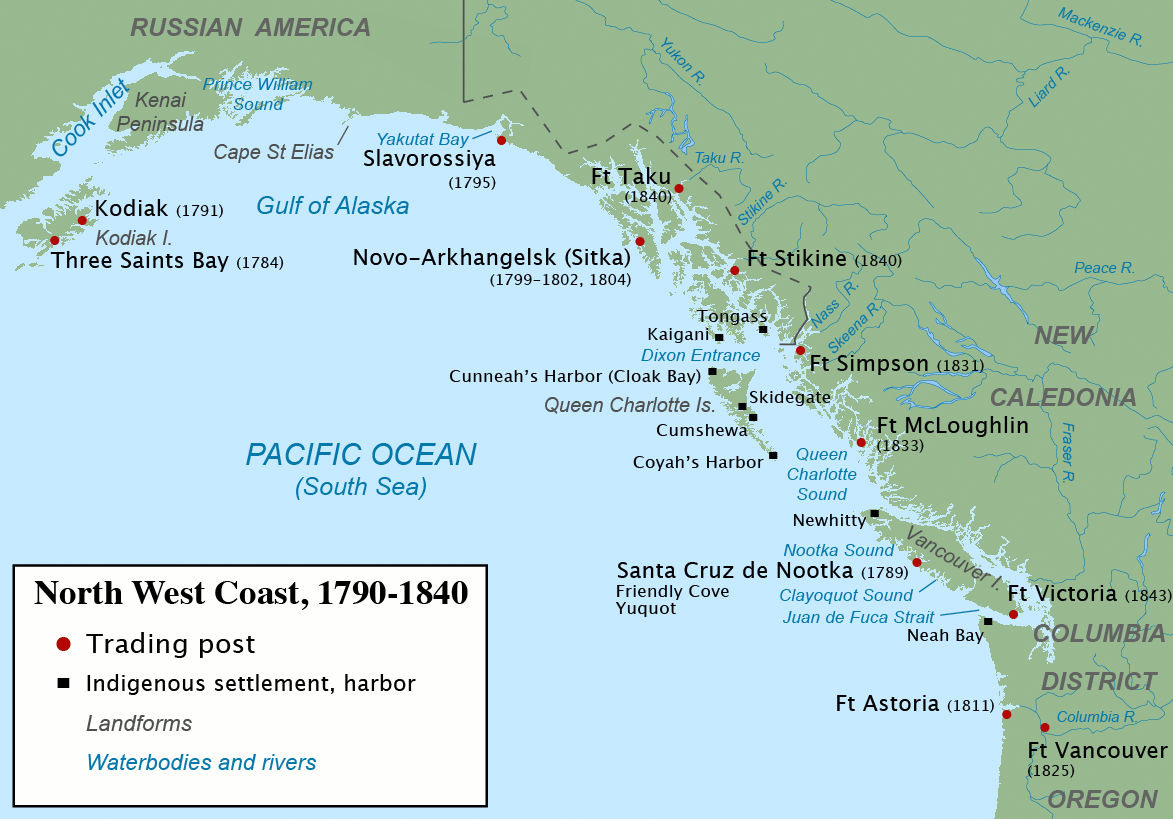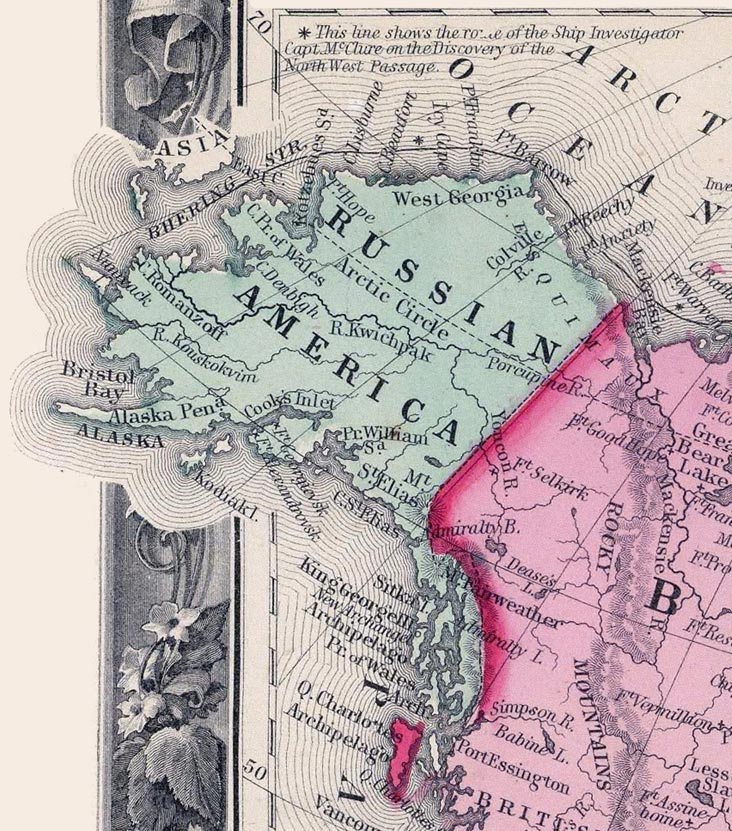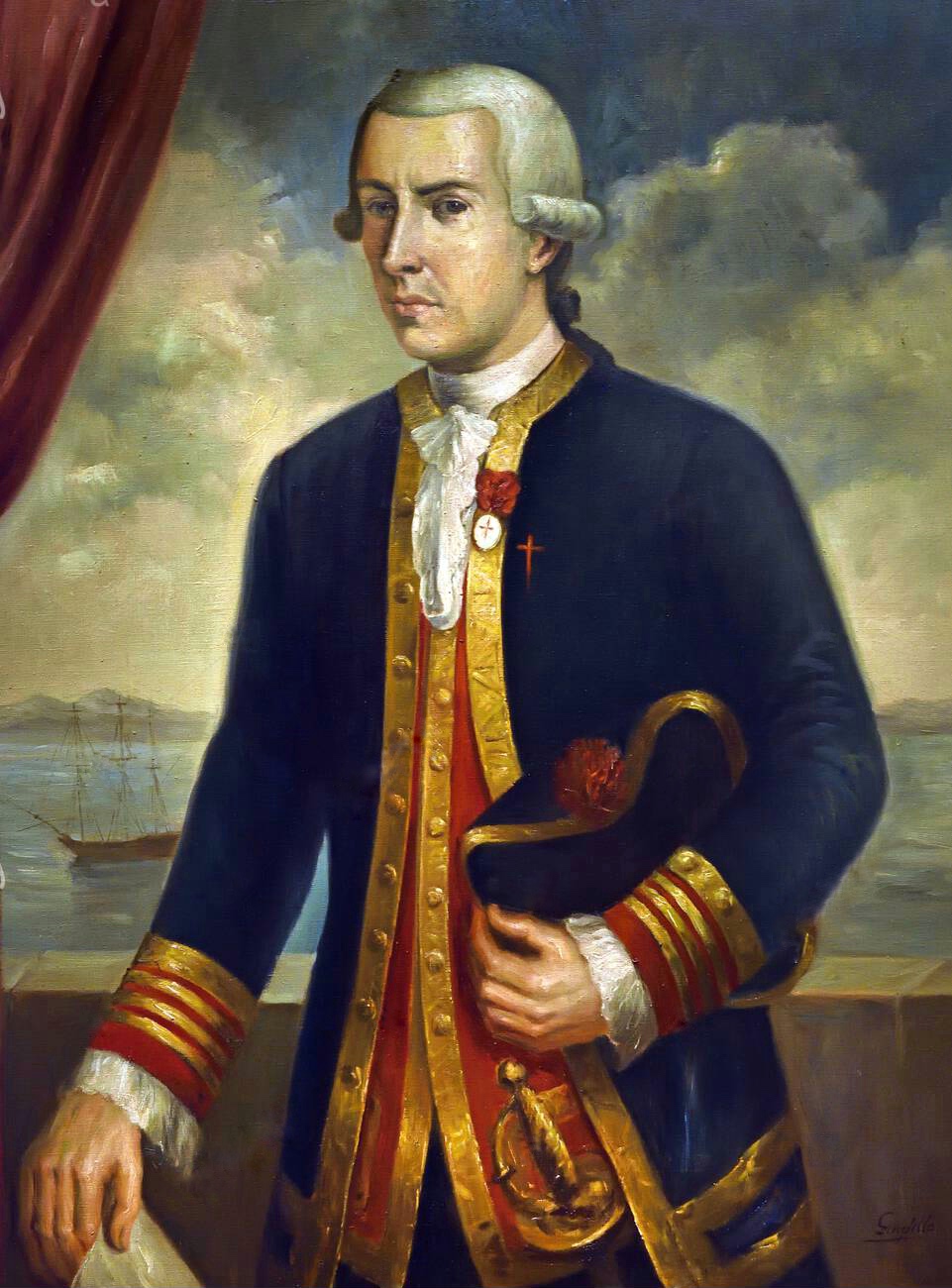|
Russian-America Company
The Russian-American Company Under the High Patronage of His Imperial Majesty (russian: –Я–Њ–і –≤—Л—Б–Њ—З–∞–є—И–Є–Љ –Х–≥–Њ –Ш–Љ–њ–µ—А–∞—В–Њ—А—Б–Ї–Њ–≥–Њ –Т–µ–ї–Є—З–µ—Б—В–≤–∞ –њ–Њ–Ї—А–Њ–≤–Є—В–µ–ї—М—Б—В–≤–Њ–Љ –†–Њ—Б—Б–Є–є—Б–Ї–∞—П-–Р–Љ–µ—А–Є–Ї–∞–љ—Б–Ї–∞—П –Ъ–Њ–Љ–њ–∞–љ–Є—П, Pod vysochayshim Yego Imperatorskogo Velichestva pokrovitelstvom Rossiyskaya-Amerikanskaya Kompaniya) was a state-sponsored chartered company formed largely on the basis of the United American Company. Emperor Paul I of Russia chartered the company in the Ukase of 1799. It had the mission of establishing new settlements in Russian America, conducting trade with natives, and carrying out an expanded colonization program. Russia's first joint-stock company, it came under the direct authority of the Ministry of Commerce of Imperial Russia. Count Nikolai Petrovich Rumyantsev (Minister of Commerce from 1802 to 1811; Minister of Foreign Affairs from 1808 to 1814) exercised a pivotal influence upon the early activit ... [...More Info...] [...Related Items...] OR: [Wikipedia] [Google] [Baidu] |
Alaska Purchase
The Alaska Purchase (russian: –Я—А–Њ–і–∞–ґ–∞ –Р–ї—П—Б–Ї–Є, Prodazha Alyaski, Sale of Alaska) was the United States' acquisition of Alaska from the Russian Empire. Alaska was formally transferred to the United States on October 18, 1867, through a treaty ratified by the United States Senate. Russia had established a presence in North America during the first half of the 18th century, but few Russians ever settled in Alaska. In the aftermath of the Crimean War, Russian Tsar Alexander II began exploring the possibility of selling Alaska, which would be difficult to defend in any future war from being conquered by Russia's archrival, the United Kingdom of Great Britain and Ireland. Following the end of the American Civil War, U.S. Secretary of State William Seward entered into negotiations with Russian minister Eduard de Stoeckl for the purchase of Alaska. Seward and Stoeckl agreed to a treaty on March 30, 1867, and the treaty was ratified by the United States Senate by a wide margi ... [...More Info...] [...Related Items...] OR: [Wikipedia] [Google] [Baidu] |
Ministry Of Commerce Of The Russian Empire
The Ministry of Commerce was the central state institution of the Russian Empire, in charge of foreign and domestic trade. It was created as part of the establishment of ministries, according to the manifesto of September 8, 1802. The former Collegium of Commerce was subordinated to the Minister of Commerce and was divided into 4 institutions: foreign trade, domestic trade, communication and customs affairs. Gavriil Gagarin was the Minister of Commerce in 1800вАУ1801 (before the ministry was established), Nikolay Rumyantsev Count Nikolai Petrovich Rumyantsev (; 3 April 1754 вАУ 3 January 1826), born in Saint Petersburg, was Russia's Foreign Minister and Chancellor of the Russian Empire in the run-up to Napoleon's invasion of Russia (1808вАУ12). He was the son of ... in 1801вАУ1810. In 1803, the Commerce Department was established. By decree of August 17, 1810, the Ministry of Commerce was disestablished and its competences were divided between the ministries: foreign trade ... [...More Info...] [...Related Items...] OR: [Wikipedia] [Google] [Baidu] |
Maritime Fur Trade
The maritime fur trade was a ship-based fur trade system that focused on acquiring furs of sea otters and other animals from the indigenous peoples of the Pacific Northwest Coast and natives of Alaska. The furs were mostly sold in China in exchange for tea, silks, porcelain, and other Chinese goods, which were then sold in Europe and the United States. The maritime fur trade was pioneered by Russians, working east from Kamchatka along the Aleutian Islands to the southern coast of Alaska. British and Americans entered during the 1780s, focusing on what is now the coast of British Columbia. The trade boomed around the beginning of the 19th century. A long period of decline began in the 1810s. As the sea otter population was depleted, the maritime fur trade diversified and transformed, tapping new markets and commodities, while continuing to focus on the Northwest Coast and China. It lasted until the middle to late 19th century. Russians controlled most of the coast of present-da ... [...More Info...] [...Related Items...] OR: [Wikipedia] [Google] [Baidu] |
Treaty Of Saint Petersburg (1825)
The Treaty of Saint Petersburg of 1825 or the Anglo-Russian Convention of 1825, officially the Convention Concerning the Limits of Their Respective Possessions on the Northwest Coast of America and the Navigation of the Pacific Ocean, defined the boundaries between Russian America and British claims and possessions of the Pacific Coast, and the later Yukon and Arctic regions of North America. It was agreed that along the coast at the southern tip of Prince of Wales island (now known as parallel 54¬∞40вА≤ north) northward to the 56 parallel, with the island wholly belonging to Russia, then to 10 marine leagues () inland going north and west to the 141st meridian west and then north to the "Frozen Ocean", the current Alaska/Canadian Yukon boundary, would be the boundary. The coastal limit had, the year before, been established as the limit of overlapping American claims in the parallel Russo-American Treaty of 1824. The Russian sphere in the region was later sold to the United Sta ... [...More Info...] [...Related Items...] OR: [Wikipedia] [Google] [Baidu] |
Russo-American Treaty Of 1824
The Russo-American Treaty of 1824 (also known as the Convention of 1824) was signed in St. Petersburg between representatives of Russia and the United States on April 17, 1824, ratified by both nations on January 11, 1825 and went into effect on January 12, 1825. The accord contained six articles. It gave Russian claims on the Pacific Northwest coast of North America south of parallel 54¬∞40вА≤ north (over what Americans had known as the Oregon Country) to the United States. The Anglo-Russian Treaty of 1825 between Russia and Great Britain then fixed the Russian Tsar's southernmost boundary of Alaska at the line of 54¬∞40вА≤N, the present southern tip of the Alaska Panhandle, but Russian rights to trade in the area south of that Iatitude remained. The Oregon dispute between the United States and Britain over jurisdiction in the region was already underway as a result of the AdamsвАУOn√≠s Treaty between the U.S. and Spain over the latter's former claims north of the 42nd Parallel ... [...More Info...] [...Related Items...] OR: [Wikipedia] [Google] [Baidu] |
Ukase Of 1821
The Ukase of 1821 (russian: –£–Ї–∞–Ј 1821 –≥–Њ–і–∞) was a Russian proclamation (a ''ukase'') of territorial sovereignty over northwestern North America, roughly present-day Alaska and most of the Pacific Northwest. The ''ukase'' was declared on September 4, 1821 ( O. S.). Jurisdiction The first section of the ukase stated that "the pursuits of commerce, whaling, fishing and other industry, on all islands, ports and gulfs, including the whole north-west coast of North America to the 45¬∞50вА≤ north latitude, are all included in this edict for the purpose of granting the same exclusivity to Russian subjects". The second section "prohibits all foreign vessels not only from landing on the coasts and islands belonging to Russia, but, also, does not permit them to approach these islands and coasts within less than one hundred Italian miles, without the vessels being subject to confiscation, along with the whole cargo" (one Italian mile was 2,025 yards/1,852 meters). The southward li ... [...More Info...] [...Related Items...] OR: [Wikipedia] [Google] [Baidu] |
Alexander I Of Russia
Alexander I (; вАУ ) was Emperor of Russia from 1801, the first King of Congress Poland from 1815, and the Grand Duke of Finland from 1809 to his death. He was the eldest son of Emperor Paul I and Sophie Dorothea of W√Љrttemberg. The son of Grand Duke Paul Petrovich, later Paul I, Alexander succeeded to the throne after his father was murdered. He ruled Russia during the chaotic period of the Napoleonic Wars. As prince and during the early years of his reign, Alexander often used liberal rhetoric, but continued Russia's absolutist policies in practice. In the first years of his reign, he initiated some minor social reforms and (in 1803вАУ04) major liberal educational reforms, such as building more universities. Alexander appointed Mikhail Speransky, the son of a village priest, as one of his closest advisors. The Collegia were abolished and replaced by the State Council, which was created to improve legislation. Plans were also made to set up a parliament and sign a con ... [...More Info...] [...Related Items...] OR: [Wikipedia] [Google] [Baidu] |
Imperial Russian Navy
The Imperial Russian Navy () operated as the navy of the Russian Tsardom and later the Russian Empire from 1696 to 1917. Formally established in 1696, it lasted until dissolved in the wake of the February Revolution of 1917. It developed from a smaller force that had existed prior to Tsar Peter the Great's founding of the modern Russian navy during the Second Azov campaign in 1696. It expanded in the second half of the 18th century and reached its peak strength by the early part of the 19th century, behind only the British and French fleets in terms of size. The Imperial Navy drew its officers from the aristocracy of the Empire, who belonged to the state Russian Orthodox Church. Young aristocrats began to be trained for leadership at a national naval school. From 1818 on, only officers of the Imperial Russian Navy were appointed to the position of Chief Manager of the Russian-American Company, based in Russian America (present-day Alaska) for colonization and fur-trade deve ... [...More Info...] [...Related Items...] OR: [Wikipedia] [Google] [Baidu] |
Sitka, Alaska
russian: –°–Є—В–Ї–∞ , native_name_lang = tli , settlement_type = Consolidated city-county, Consolidated city-borough , image_skyline = File:Sitka 84 Elev 135.jpg , image_caption = Downtown Sitka in 1984 , image_size = 260 , image_flag = , image_seal = , nickname = , motto = , image_map = Map of Alaska highlighting Sitka City and Borough.svg , map_caption = , coordinates = , subdivision_type = , subdivision_name = , subdivision_type1 = U.S. state, State , subdivision_type2 = , subdivision_name1 = , subdivision_name2 = , established_title = Colonization, Colonized , established_date = 1799, 1804 , established_title2 = Municipal corporation, Incorporated , established_date2 = November 5, 1913 (city)September 24, 1963(borough)De ... [...More Info...] [...Related Items...] OR: [Wikipedia] [Google] [Baidu] |
Kodiak, Alaska
Kodiak ( Alutiiq: , russian: –Ъ–∞–і—М—П–Ї), formerly Paul's Harbor, is the main city and one of seven communities on Kodiak Island in Kodiak Island Borough, Alaska. All commercial transportation between the island's communities and the outside world goes through this city via ferryboat or airline. As of the 2020 census, the population of the city is 5,581, down from 6,130 in 2010. It is the tenth-largest city in Alaska. Originally inhabited by Alutiiq natives for over 7,000 years, the city was settled in the 18th century by the subjects of the Russian crown and became the capital of Russian Alaska. Russian harvesting of the area's sea otter pelts led to the near extinction of the animal in the following century and led to wars with and enslavement of the natives for over 150 years. The city has experienced two natural disasters in the last century: a volcanic ashfall from the 1912 eruption of Novarupta and a tsunami from the 1964 Alaska earthquake. After the Alaska Pur ... [...More Info...] [...Related Items...] OR: [Wikipedia] [Google] [Baidu] |
Bodega Bay, California
Bodega Bay is a village and census-designated place (CDP) in Sonoma County, California, United States. The population was 912 at the 2020 census. The town, located along State Route 1, is on the eastern side of Bodega Harbor, an inlet of Bodega Bay on the Pacific coast. History Bodega Bay is the site of the first Russian structures built in California, which were erected in 1809 by Commerce Counseller Ivan Alexandrovich Kuskov of the Russian-American Company in the lead-up to the establishment of Fort Ross. The Russians named the settlement in Bodega Bay Port Rumyantsev after the Russian Foreign Minister Nikolai Petrovich Rumyantsev, and it served as a port to support Fort Ross and the larger Russian community known as Colony Ross. The town is now named in honor of Juan Francisco de la Bodega y Quadra, a Spanish naval officer who explored the west coast of North America as far north as Alaska during multiple voyages of discovery in the late 18th century. The location scene ... [...More Info...] [...Related Items...] OR: [Wikipedia] [Google] [Baidu] |
Fort Ross, California
Fort Ross ( Russian: –§–Њ—А—В-–†–Њ—Б—Б, Kashaya ''m√©¬Јбє≠i Фni''), originally Fortress Ross ( pre-reformed Russian: –Ъ—А—£–њ–Њ—Б—В—М –†–Њ—Б—Б—К, tr. ''Krepost є Ross''), is a former Russian establishment on the west coast of North America in what is now Sonoma County, California. It was the hub of the southernmost Russian settlements in North America from 1812 to 1841. Notably, it was the first multi-ethnic community in northern California, with a combination of Native Californians, Native Alaskans, and Russians. It has been the subject of archaeological investigation and is a California Historical Landmark, a National Historic Landmark, and on the National Register of Historic Places. It is part of California's Fort Ross State Historic Park. Etymology The present name of Fort Ross appears first on a French chart published in 1842 by Eug√®ne Duflot de Mofras, who visited California in 1840. The name of the fort is said to derive from the Russian word rus or ''ros'', the ... [...More Info...] [...Related Items...] OR: [Wikipedia] [Google] [Baidu] |







.jpg)